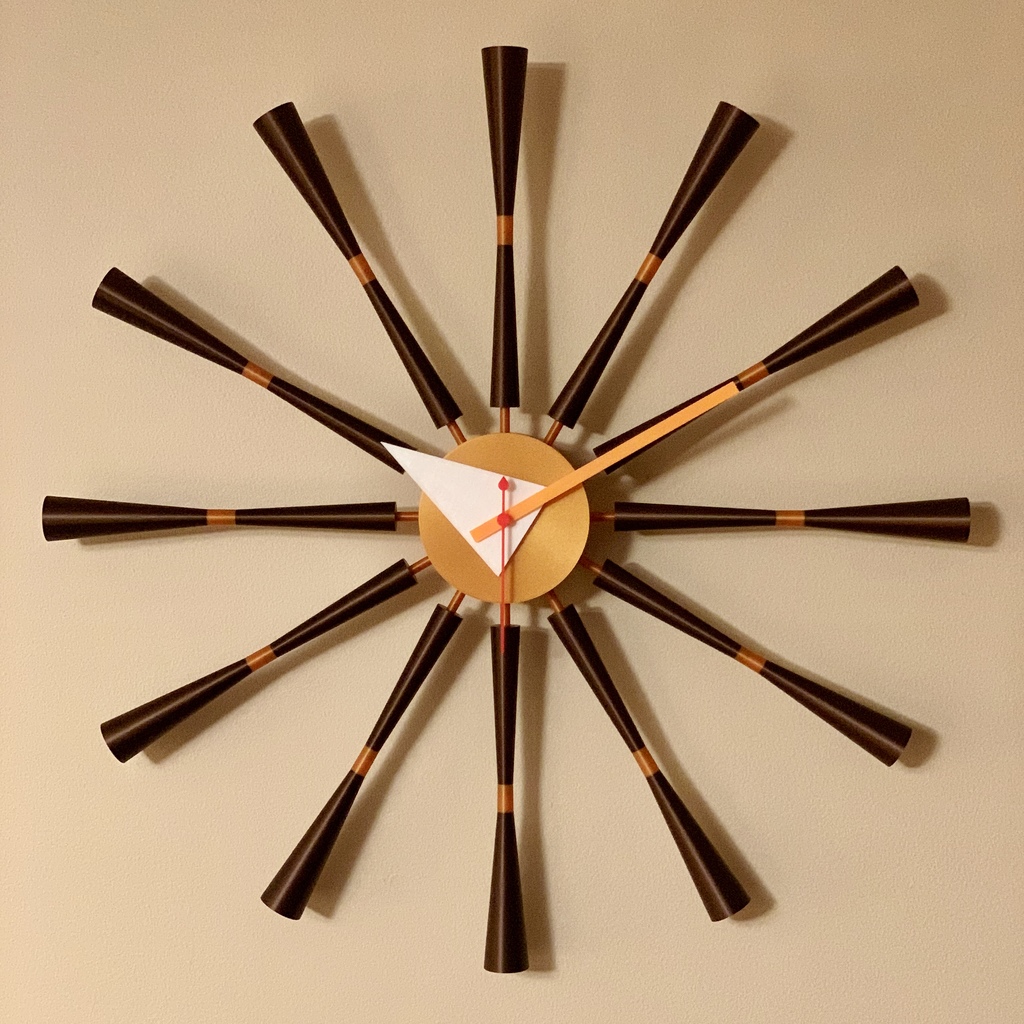
George Nelson Spindle Clock Re-Creation
thingiverse
As an admirer of George Nelson's distinctive design style, I decided to recreate his iconic Vintage Spindle Clock and transform it into a 3D printing project. The model was carefully drawn in Rhino 3D, precision sliced using Slic3r PE, and printed on a Prusa MK3 printer with MatterHackers Pro Series PLA. Someday, I hope to own an authentic George Nelson clock, but for now, I've decided to create my own version. For more information about the legendary designer, visit http://www.georgenelsonfoundation.org/. Here are the materials and settings used: Clock Casing: 1 needed - Gold Filament with 20% infill, Top & Bottom layer settings: Archimedean Cords, Seam Position set to Rear, Remove any debris from the nut pocket before inserting the nut. Clock Spoke Connectors: 12 needed - Gold Filament with 100% infill, Top & Bottom layer settings: Archimedean Cords, Seam Position set to Rear. Clock Retaining Ring: 1 needed - Gold Filament with 20% infill, Top & Bottom layer settings: Archimedean Cords, Seam Position set to Rear. This part is used to lock all the Spoke Connectors in place and provide a resting spot for the Clock Back. Spoke Connector Glue Template: Used to ensure proper alignment of the Spoke Connectors during assembly. Clock Hands: Designed specifically for this movement, available at https://www.amazon.com/Hicarer-Torque-Quartz-Movement-Replacement/dp/B07DKY3LP9/ref=sr_1_8?keywords=High%2BTorque%2Bclock%2Bmovement&qid=1550337416&s=gateway&sr=8-8&th=1. Assembly Instructions: 1. Begin with the Clock Casing, 2 M3ns nuts, all 12 Spoke Connectors, the Clock Retaining Ring, and the Spoke Connector Glue Template. 2. Install the M3ns nuts into the nut pockets, removing any debris beforehand to prevent damage to the support column. Gently apply pressure while installing the nuts to avoid breaking the support column. 3. Install all 12 Spoke Connectors, applying glue around the notch and end of each part. I used clear glue that allows for setting time. 4. Secure the Clock Retaining Ring in place, ensuring all Spoke Connectors are locked in position. 5. Place the Clock Casing assembly (back facing up) in the Spoke Connector Glue Template to ensure proper alignment of the Spoke Connectors. Rotate each part so that the print seam faces the back of the clock. 6. While the glue is setting on the Spoke Connectors, gather all the Spoke Parts (Top, Middle, and Bottom) and begin gluing them together using the Spoke Parts Glue Template to ensure proper alignment. Rotate each part so that the print seams line up. 7. Set up the 4 Spoke Glue Templates around the Spoke Connector Glue Template. 8. Next, glue all 12 Clock Spokes onto the Spoke Connectors using the Spoke Glue Templates to ensure proper alignment. Rotate each Spoke so that the print seam faces the back of the clock. 9. Once the glue on the Spokes has set, lift the clock away from the Glue Templates and install the Clock Movement using the supplied locking nut. 10. Install the Clock Back using the 2 M3x18 fasteners. Remove any debris from the fastener pockets beforehand to prevent damage. Align the opening of the Clock Back with the battery port on the Clock Movement for easy access. 11. Install the Clock Hands, starting with the Hour Hand, followed by the Minute Hand and then the Second Hand. Insert the AA battery and set the time. 12. Your project is complete! Find a suitable spot to display your newly assembled clock, and don't forget to share a picture on Thingivers! This project is licensed under a Non-Commercial License, allowing you to create one for personal use or as a gift for friends and family.
With this file you will be able to print George Nelson Spindle Clock Re-Creation with your 3D printer. Click on the button and save the file on your computer to work, edit or customize your design. You can also find more 3D designs for printers on George Nelson Spindle Clock Re-Creation.
